29 Types Of SMALL Birds In California (ID Guide With Photos)
Did you recently come across a small bird in California, and want to know what species it was?
Identifying small backyard birds in California is not as easy as it might seem, since there are many species of birds in the Golden State that are on the small side.
To help you identify the bird you saw, we’ll cover the most common small birds of California in this article.
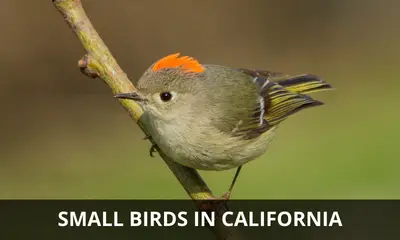
What are the types of small California birds?
The 29 types of small birds commonly found in California are:
- House Wren
- Rock Wren
- Lesser Goldfinch
- Anna’s Hummingbird
- Western Bluebird
- Verdin
- Cactus Wren
- Black-chinned Hummingbird
- Yellow Warbler
- Yellow-rumped Warbler
- Lazuli Bunting
- Vermilion Flycatcher
- Blue-gray Gnatcatcher
- Barn swallow
- Tree swallow
- Ruby-crowned Kinglet
- Downy Woodpecker
- Common Yellowthroat
- Summer Tanager
- Western Tanager
- European Starling
- House Finch
- Red-winged Blackbird
- Common Ground Dove
- Blue Grosbeak
- American Goldfinch
- Chipping Sparrow
- Song Sparrow
While many of these birds are found year-round in California, a number of birds only occur in the state during the nesting season in summer.
Yet other species are winter visitors in California, and some are vagrants that only rarely occur in the state.
Now let’s dive into the details, and take a closer look at each of these bird species in order to get the full scoop:
House Wren
Scientific name: Troglodytes aedon
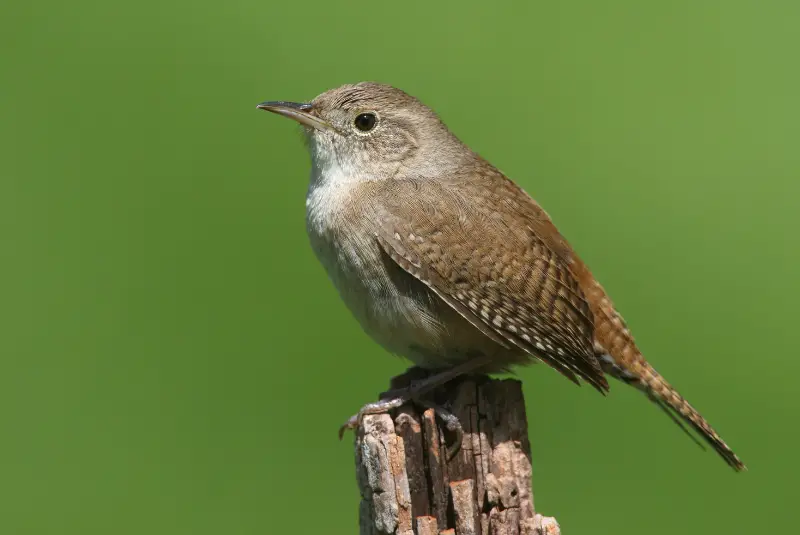
The House Wren is a small songbird with a relatively long beak. Compared to other wrens, it has a long tail, which it likes to cock up.
At a distance, House Wrens resemble uniformly brown birds, but when viewed close up, you can discern subtle barring on their wings and tail.
This small bird has a surprisingly loud voice, and if you hear one singing next to you, it appears almost deafeningly loud, drowning out all other birdsong in the vicinity.
Similar to the Rock Wren, the House Wren is a year-round resident in California, and can be seen in coastal areas of the state.
Rock Wren
Scientific name: Salpinctes obsoletus
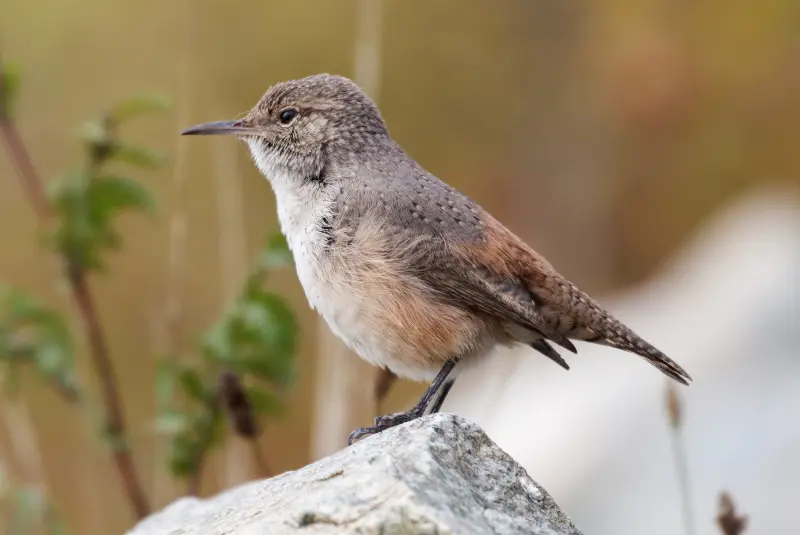
The Rock Wren is a compact little songbird with a powerful singing voice, and is most often observed perched on an exposed rock while flicking its tail energetically.
These small wrens are inconspicuously colored, and are largely gray-brown with white speckles, plus a slight tint of reddish orange on their rump and white speckles on their crown and back.
While northern populations of Rock Wrens are migratory, California birds are resident, and can be seen in the Golden State year-round. However, they sometimes move to lower altitudes in cold weather.
When foraging for insects on the ground, they move around with a bouncy gait while flicking their tail.
Lesser Goldfinch
Scientific name: Spinus psaltria
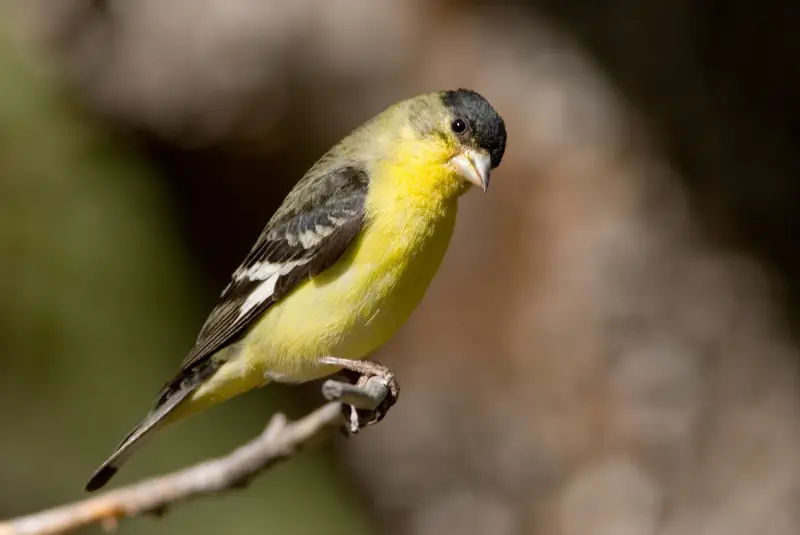
The Lesser Goldfinch is a common breeding bird in California, and occurs in a broad swath across the southern half of the state.
Adult males have a black cap and black wings, which contrast with bright yellow underparts. Their black wings have a white stripe, which is most obvious in flight.
Females and juveniles are olive green, with lighter underparts and dark wings with a white wing bar.
The Lesser Goldfinch is a year-round resident in California, and outside of the breeding season it likes to forage in flocks, mainly feeding on thistles.
Anna’s Hummingbird
Scientific name: Calypte anna
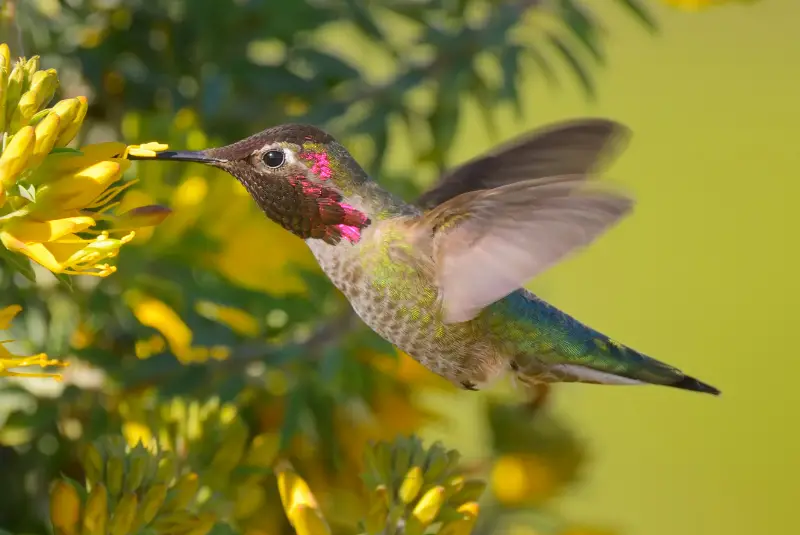
A compact Calypte hummingbird species that thrives in human habitats, Anna’s Hummingbird is the smallest bird found in California.
This intrepid hummingbird has steadily and relentlessly increased its breeding range since the early 1900’s, spreading from coastal California to more interior regions of the continent.
And as part of this expansion of its range, Anna’s Hummingbird has colonized urban areas in California and other desert states of the southwestern United States.
This tiny bird is now a common backyard bird in California, where it nests in gardens, parks, and other urban areas.
Anna’s Hummingbirds are highly adaptive when foraging for food, and are able to utilize a broad range of nectar sources, including flowering trees and shrubs from different continents.
Western Bluebird
Scientific name: Sialia mexicana
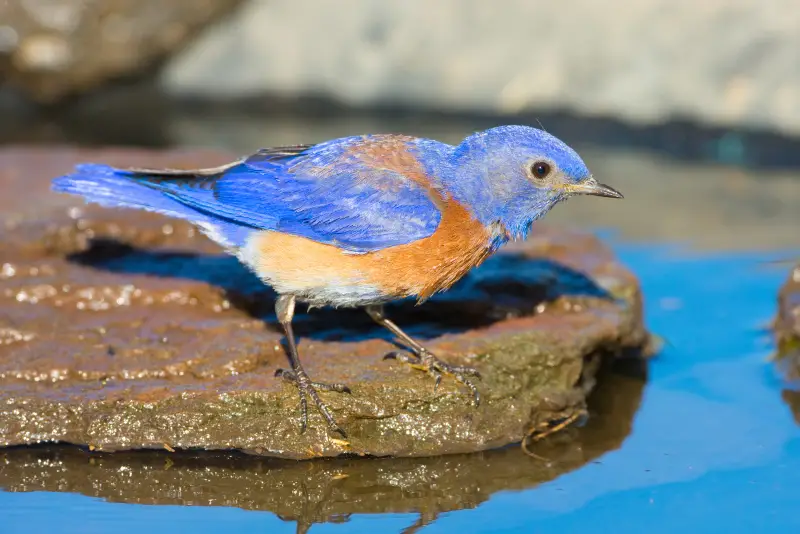
The Western Bluebird is the most common bluebird species found in California.
It is a breeding bird and year-round resident in the northern half of California, and also occurs in southern parts of the state during the winter season.
Male Western Bluebirds have a deep shade of blue on their heads and backs, which contrasts with reddish orange feathers on the chest.
Female and juvenile birds on the other hand, have more subdued hues, with gray-brown upperparts and a lighter gray underside.
While Western Bluebirds are migratory birds in northern parts of their range, they are permanent residents in the Golden state.
These birds nest in treeholes or nestboxes, but have suffered from the competition with House Sparrows and European Starlings, which are more aggressive and chase bluebirds away from their nest sites.
The population of Western Bluebirds underwent a dramatic decline at the end of last century, due to lack of nesting holes and competition with European Starlings.
However, thanks to the efforts of numerous California citizens providing nest boxes for Western Bluebirds, these birds are a common sight in California once more.
Verdin
Scientific name: Auriparus flaviceps
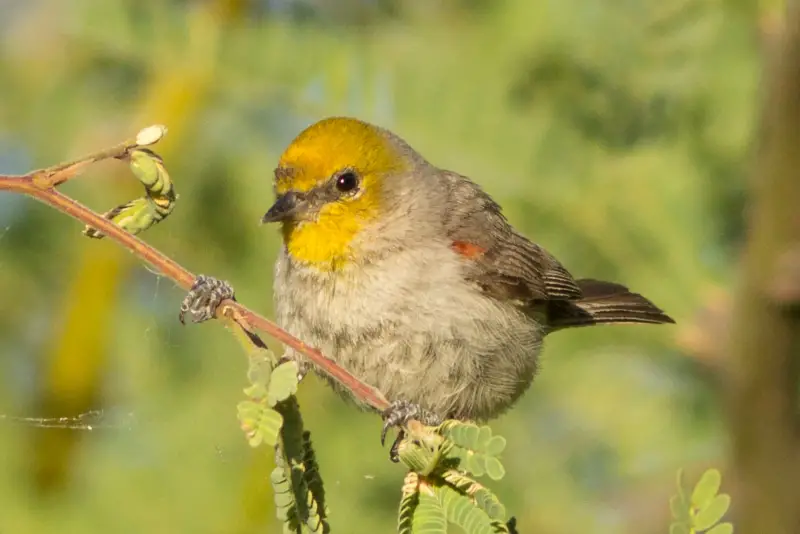
The Verdin is characterized by a slender body and an unusually slim beak that is more reminiscent of a warbler.
The colors of male and female Verdins are broadly similar, although the male’s yellow plumage is generally brighter.
The back, neck, and wings of adults are unassuming gray, contrasting with a startlingly bright yellow face, as well as piercing dark eyes.
And while it is an energetic feeder, twitching its tail as it goes, it can sometimes be difficult to spot, since it usually forages alone.
The Verdin is a regular breeding bird in the arid regions of southern California, including the Mojave Desert, where it can be seen all year round.
Cactus Wren
Scientific name: Campylorhynchus brunneicapillus
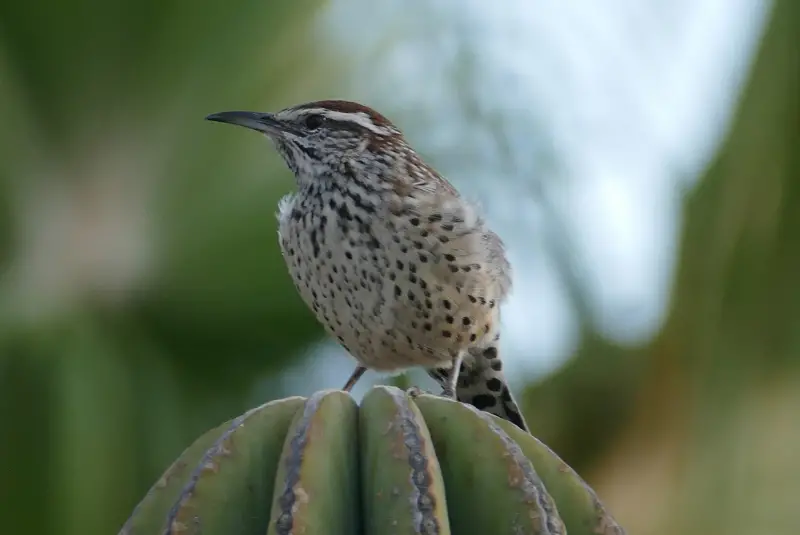
If you notice a small desert bird resembling a cross between a thrasher and a wren perched on a cactus, you’re probably looking at a Cactus Wren.
Both sexes of this bird look alike, and are predominantly grayish brown with dark brown spots and streaks thrown in for good measure.
The best distinguishing features of the Cactus Wren are its brown crest, the long and slightly downturned bill, as well as the bright white eyebrow stripe.
You can also identify it by its harsh, chattering call, which sounds like someone trying to start a car. If you get close enough to one of these birds, you’ll notice that their eyes are dark ruby red.
The Cactus Wren is a year-round resident of the southern half of California, and is commonly found in desert landscapes.
As you might have guessed from its name, it’s often found near cacti and uses them as a lookout when searching for insects and other small invertebrates on the ground.
Black-chinned Hummingbird
Scientific name: Archilochus alexandri

The Black-chinned Hummingbird is native to western California, and together with the Ruby-throated Hummingbird, it is one of the smallest California birds.
It is a common and adaptable species that does well in a wide variety of natural and man-made habitats.
This hummingbird species is a generalist, which explains why it thrives in so many different habitats, ranging from remote deserts and mountains to parks and backyard gardens.
Males can be recognized by their dark head and black throat, while females and immature birds are more drably colored.
Black-chinned Hummingbirds are not as aggressive as other species of Hummingbirds, and are thus often dominated by other Hummingbirds.
This tiny California bird favors a wide variety of woodland and shrubland habitats, as well as urban areas. It is largely migratory, and spends the winter in the western part of Mexico.
Yellow Warbler
Scientific name: Setophaga petechia
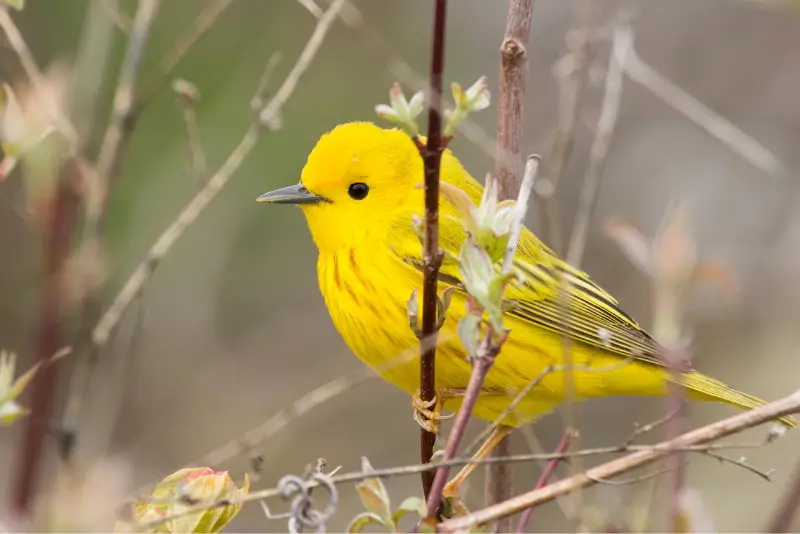
Also known as the American Yellow Warbler, this songbird lives up to its name.
Adult males have a brilliant yellow color, except for their wings, which are just slightly darker and have two pale wingbars.
They also have reddish stripes on the breast and the yellow sides. Adult females are very similar to the males, but have less black streaking and are thus more uniformly yellow.
These bright yellow California birds are summer visitors in the state during the months from May to late August.
This species is found in open habitat with low thickets and scrubland, which makes it easy to observe.
Yellow-rumped Warbler
Scientific name: Setophaga coronata

While the sexes of the Yellow-rumped Warbler are dissimilar, they both have a yellow rump.
This small warbler exists in several variations, and the population in east California are also called “Myrtle Warblers”.
These small warblers have blueish-gray upperparts with dark streaks, as well as a yellow rump and yellow flanks.
The Yellow-rumped Warbler is a summer breeding bird in northern California, and a winter visitor in the southern parts of the state, where it can be seen from August through April.
Lazuli Bunting
Scientific name: Passerina amoena
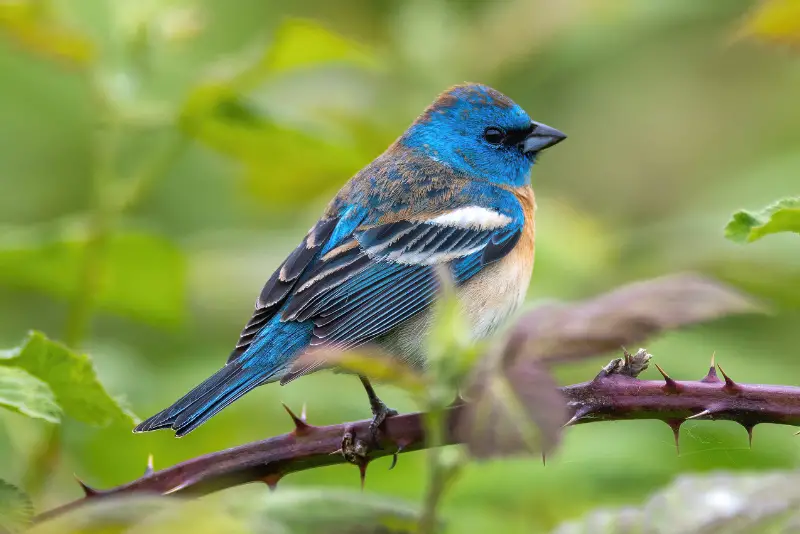
The Lazuli Bunting is a gorgeous little songbird of the western United States that visits and breeds in northern California during the summer.
The hood, neck, and rump of adult males are light blue, while the wings are dark gray with a white wingbar. Males also have a chestnut orange breast and a white belly throughout the summer months.
Females are buff-brown in color with black wings and a pale blue rump.
The Lazuli Bunting may be found in California during the breeding season, which runs from May to August, before migrating to Mexico for the winter.
Vermilion Flycatcher
Scientific name: Pyrocephalus obscurus
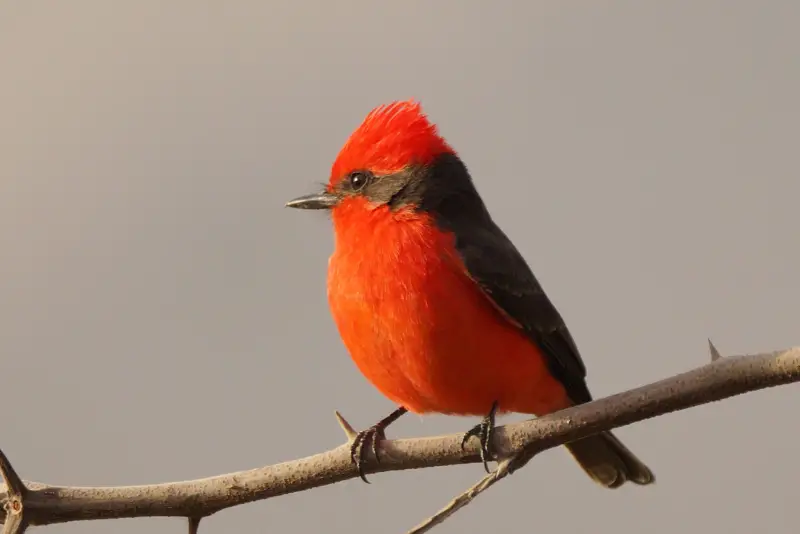
One of the most beautiful small birds that can be seen in California, the Vermilion Flycatcher is often found in the arid landscapes of the Mojave Desert.
Adult males have a scarlet red underside, throat, and crown, while the rest of their body is dark brown.
Females and immature birds, on the other hand, are grayish brown on top, and pale underparts.
It is a strict migratory bird, with most Vermilion Flycatchers migrating to Central America to spend the winter, with only a handful of individuals remaining in North America during the cold season.
A great thing about this small red bird in California is that it isn’t very shy towards humans, and usually can be easily observed on exposed perches.
The preferred habitat of the Vermillion Flycatcher is open woodland and parks in areas close to water.
Blue-gray Gnatcatcher
Scientific name: Polioptila caerulea
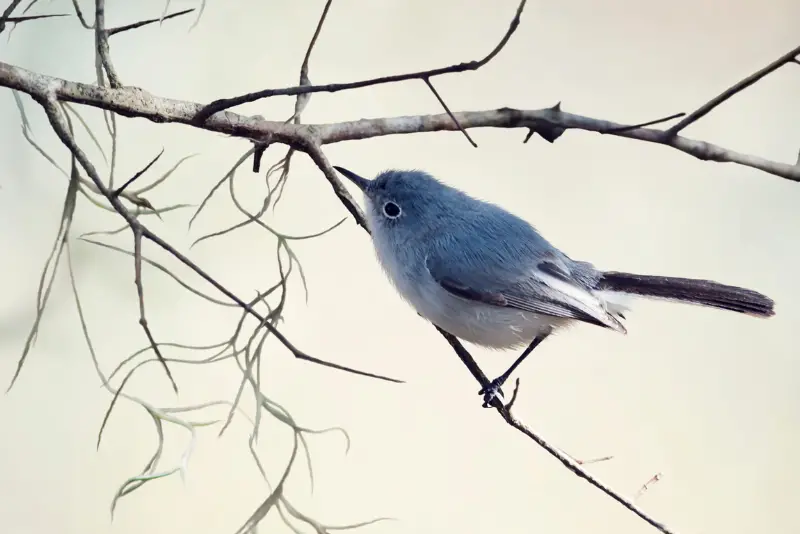
Except for its long tail, the Blue-gray Gnatcatcher looks a lot like a warbler.
The upperparts of adult males are blue-gray, while their underparts are a lighter gray. The tail is black with a white stripe at the margins.
Adult females and immature birds are rayish on top, and light gray underparts. The eye of both sexes has a white eyering.
It may be encountered as a breeding bird in the temperate regions of North America, predominantly from early May through August.
It is a partial migratory bird, with southeastern populations being year-round residents. Northern populations, however, spend the winter in the southern USA and Central America.
A great way to identify this tiny bird is by its long tail that is often cocked upwards.
Barn Swallow
Scientific name: Hirundo rustica
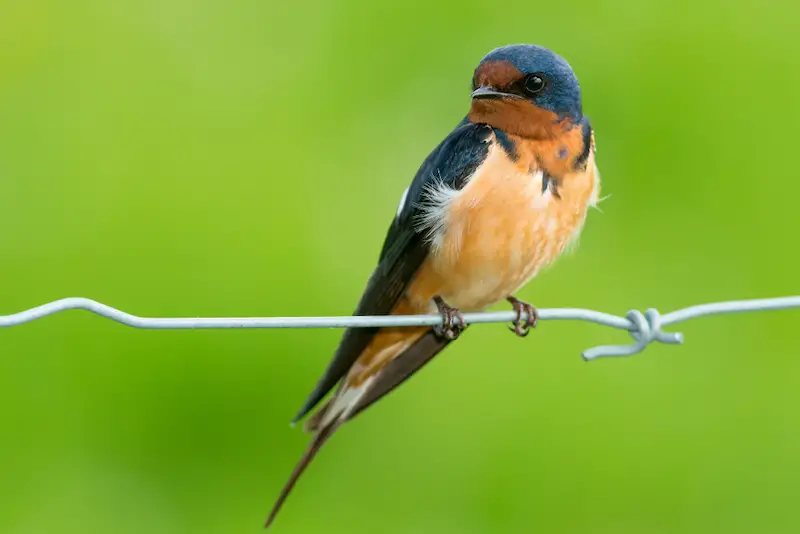
The Barn Swallow inhabits nearly all of North America south of the Arctic circle and may be found in a wide variety of habitats.
It has iridescent blue upperparts that shimmer in various shades of dark blue when the sunlight hits them.
Its underside is reddish-orange, including a chestnut orange forehead and throat, as well as a light reddish-orange belly.
The deeply forked tail of Barn Swallows is another great feature you can use to identify this bird.
However, keep in mind that immature barn swallows have a duller plumage than adults, as well as a shorter tail that is less forked.
The Barn Swallow used to nest in caves and hollow trees, but nowadays it prefers to do so beneath the overhangs of buildings and bridges, as well as inside barns (which explains how it got its name).
These California swallows are still a reasonably common sight in most areas. However, the overall numbers of Barn Swallows have been steadily decreasing, especially in the northern section of their range.
This decline is likely a result of the loss of foraging areas and nesting opportunities.
The Barn Swallow feeds on flying insects, such as mosquitoes and flies, and catches them closer to the ground than other species of swallows. In its winter quarters it also feeds on termites.
It is a strictly migratory bird, and spends the winter in Central and Southern America.
Tree Swallow
Scientific name: Tachycineta bicolor

The Tree Swallow is relatively common in California, and is most often found close to lakes, marshes, and ponds.
Adult Tree Swallows are greenish blue on top, and have buff white underparts. Their feathers are iridescent, and change color when viewed in direct sunlight.
While adult females look similar to adult males, young birds are more grayish brown with a white underside.
This swallow readily accepts suitable nesting boxes, which gives you an opportunity to attract this attractive blue-colored bird in California to your backyard.
This blue bird feeds exclusively on insects that it catches in the air, and as a strict insectivore this bird is a long distance migrant that only spends the summer in California.
Tree Swallows winter around the Gulf of Mexico, as well as in Central America.
Ruby-crowned Kinglet
Scientific name: Regulus calendula
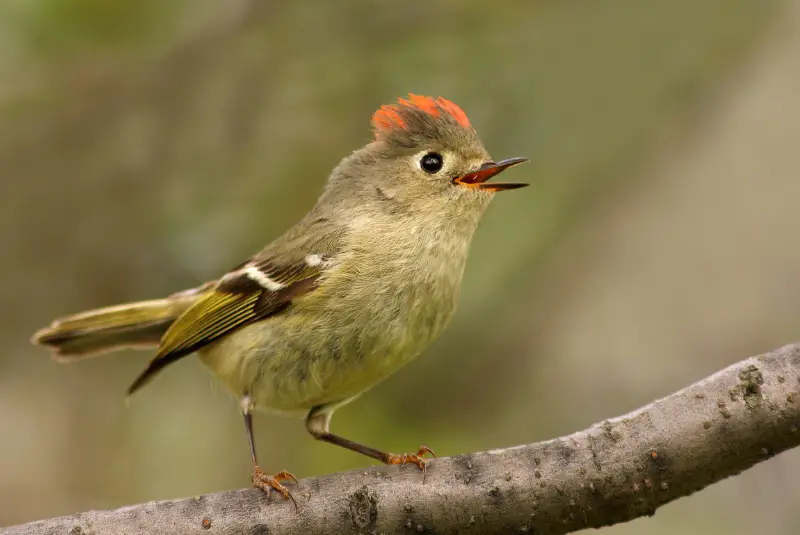
The Ruby-crowned Kinglet is a tiny bird that is best identified by its ruby-red crown on its head, although this is only present in adult males.
Females and juveniles look similar to males, but lack the red crown patch. They are regular breeding birds in California, where they can be found in a range of woodland habitats.
Outside of the breeding season, there is a large influx of Ruby-crowned Kinglets that winter in California, and at this time of the year they can be encountered throughout the state.
Kinglets are “hyperactive” birds that are always on the go, looking out for insects in the leaves of shrubs and trees.
Downy Woodpecker
Scientific name: Picoides pubescens

The Downy Woodpecker is the smallest woodpecker found in California.
While males are colored black and white with a small red patch on their nape, females are entirely black and white.
The wings of both sexes are black with white bars, which look like spots when the wings are folded.
Downy Woodpeckers are non-migratory, and can be seen all year round in east California, but they don’t occur in the arid regions in the southwest.
You can tell this woodpecker apart from the Hairy Woodpecker by its smaller size and short bill.
While Downy Woodpeckers don’t migrate, they like to move around outside of the breeding season, in search of areas with plentiful food.
Their preferred habitat is deciduous or mixed forest, where they feed on insects and insect larvae found under the bark of trees. During winter they also eat berries and seeds.
Common Yellowthroat
Scientific name: Geothlypis trichas
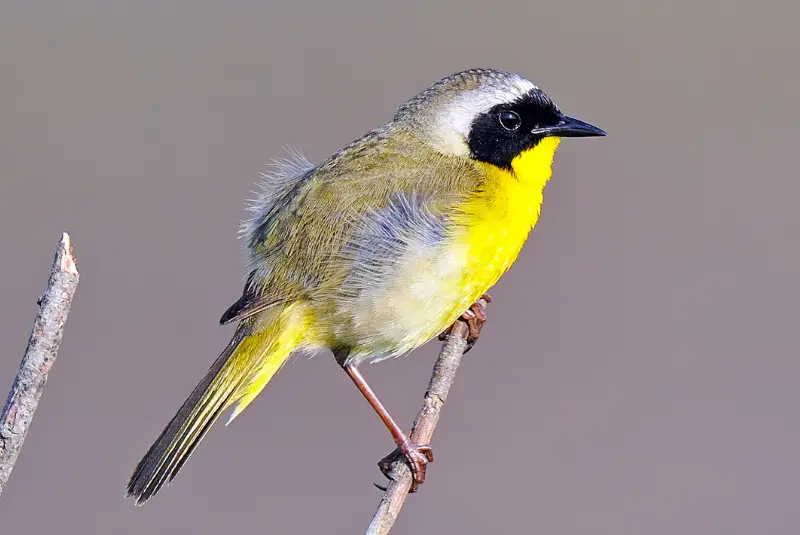
The Common Yellowthroat is a brightly colored small wood warbler. Adult males have a bright yellow throat and chest, as well as a broad black mask that covers the forehead and cheeks.
The black face mask is bordered on top by a grayish white band, which transitions into the olive brown nape and back. Females are similar, but lack the black face mask.
The Common Yellowthroat is a small bird that can be found in southeastern California during the winter months, where it is found in the arid landscapes of the Mojave Desert.
It prefers shrubland and grassy habitats, and feeds on insects and other invertebrates.
Summer Tanager
Scientific name: Piranga rubra
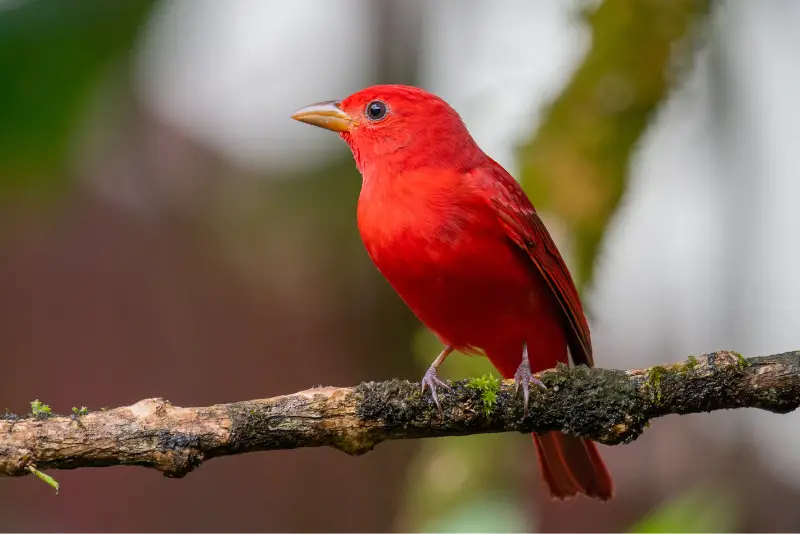
The Summer Tanager is a beautiful and alluring little songbird with a peaked (as opposed to rounded) crown.
Adult male Summer Tanagers are entirely bright red, although they have slightly darker feathers on their wings.
It can be hard to observe Summer Tanagers, since they like to forage high in the treetops of deciduous and mixed forests.
In contrast to males, females and immatures are buff yellow, although they sometimes have a few patches of pale red.
The Summer Tanager is a summer visitor and breeding species in California, and can be seen here from May through August.
This small songbird is strictly migratory, and spends the rest of its year in Mexico and Central America.
Western Tanager
Scientific name: Piranga ludoviciana
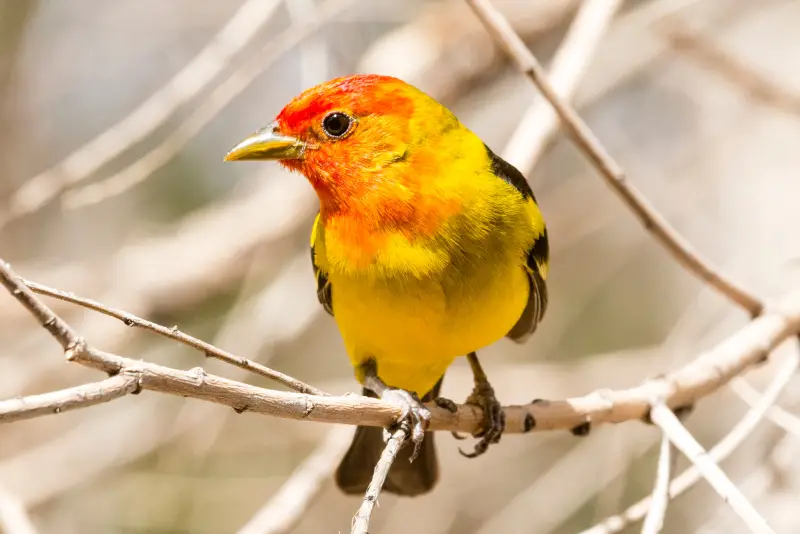
With its brilliant hues, male Western Tanagers are difficult to overlook.
Adult males have a black back, tail, and wings in the summer, with two yellow and white wingbars. Their bodies are yellow, while their head and throat are orange-red.
Females and juvenile birds have a similar appearance, but the yellow is duller and the red color is almost absent, with the exception of a speck near the base of the beak.
The Western Tanager may be seen in northern California during the breeding season from May to August. These exotically colored birds spend the remainder of the year in Central America.
European Starling
Scientific name: Sturnus vulgaris
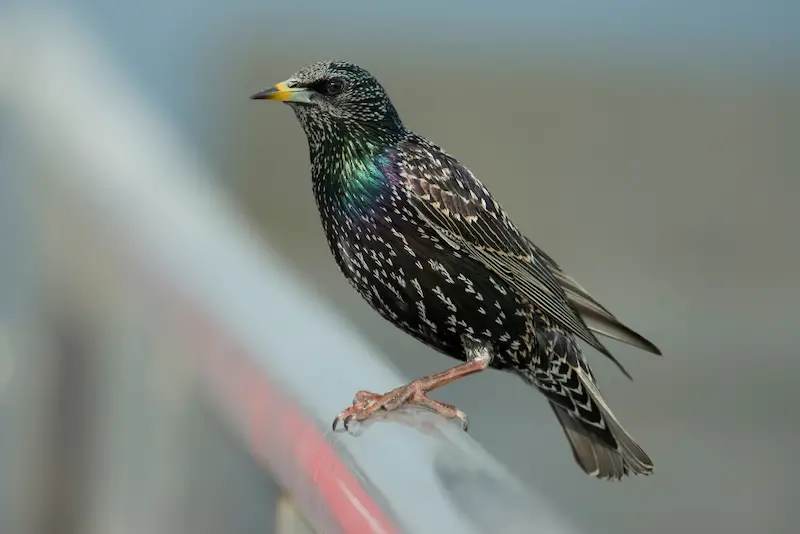
The European Starling is a common backyard bird in California. Adult European Starlings are uniformly black with a glossy sheen.
During winter, the black feathers of European Starlings are covered with light spots, which can be a great characteristic to identify them.
This species is originally from Europe, Asia, and North Africa, but it was introduced to North America and many other parts of the world, where it has established itself as a successful breeding species within a short period of time.
European Starlings inhabit open country with few trees as their original habitat, but they are also among the most successful urban birds, and are especially common in parks and gardens.
While European Starlings nest in tree holes in the wild, they are also known to nest inside buildings and nest boxes in urban settings.
Unfortunately, native birds are sometimes driven out of their nesting sites by competing Starlings.
Similar to grackles and other blackbirds, European Starlings form large flocks outside of the nesting season.
These flocks can contain more than a million individuals, and can be seen performing amazing aerial acrobatics.
House Finch
Scientific name: Haemorhous mexicanus
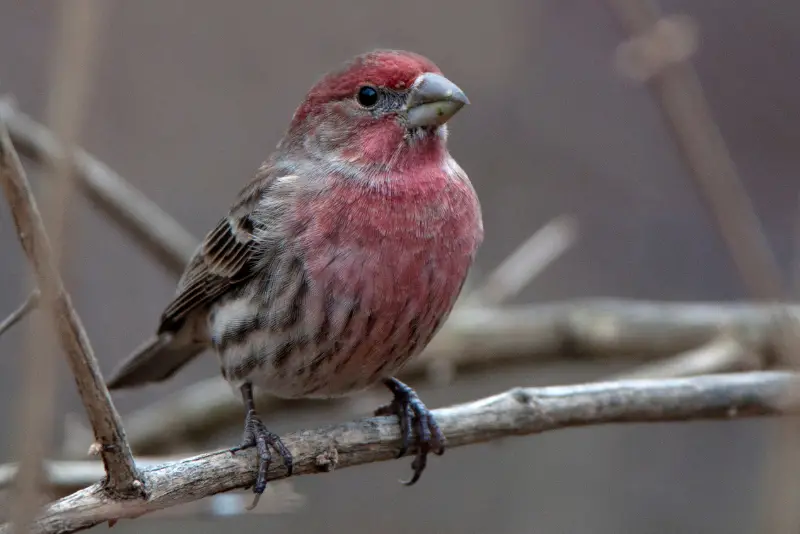
The House Finch is one of the most common small birds found in California, and is usually found in settled areas, ranging from small towns to large metropolitan centers.
Adult male House Finches can be identified by the bright red feathers on the head and upper breast, although in some cases they are more orangeish or yellowish in color.
The females lack any red coloration, and instead have grayish streaks on a brown background.
This small finch was originally a western bird, and it wasn’t until the 1940s that it was discovered in New York and other places on the east coast of the US.
The eastern House Finch population began to grow in the 1950s and 60s, and by the year 2000, it had expanded so far west that it connected with the original western population.
The House Finch is entirely herbivorous, and feeds on seeds, buds, and fruits.
If you set up a bird feeder in your backyard, you can expect House Finches to be among the first birds to visit it.
The House Finch is found in California all year round. And while it is not a migratory bird, it does move to areas with the most plentiful food supply outside of the breeding season.
Red-winged Blackbird
Scientific name: Agelaius phoeniceus

The Red-winged Blackbird is one the most abundant birds in California, and it is one of the most common blackbirds in California during the summer.
The great thing about these California blackbirds is that you can easily distinguish males from females.
Male Red-winged Blackbirds are completely black except for the bright red patches on their wings. In contrast, females (and juveniles) are a blackish brown color with white streaks.
Generally speaking, this blackbird lives in open fields and near water. It is often found in marshes, wetlands, and around lakes.
To find food, the Red-winged Blackbird travels many miles a day, especially outside of the nesting season.
While this blackbird is primarily a seed-eater during fall and spring, it switches to feeding almost exclusively on insects during summer.
Depending on where it is found, the Red-winged Blackbird is either a seasonal migrant (in the north of its range), or a resident (in the south of its range).
Red-winged Blackbirds roost in flocks up to millions of individuals strong, creating a deafening noise with their rapidly beating wings.
In spring, males are usually the first ones to arrive in order to claim a desirable territory before the females arrive.
During the mating season, the male will sing from a conspicuous perch and display the red shoulder patches on his feathers in order to attract the attention of females.
After a female chooses a mate, she builds her nest over shallow water in a thick stand of vegetation. Her chosen mate then aggressively defends the nest against other blackbirds.
The most successful males are bigamous, and can mate with multiple females at the same time.
Common Ground Dove
Scientific name: Columbina passerina
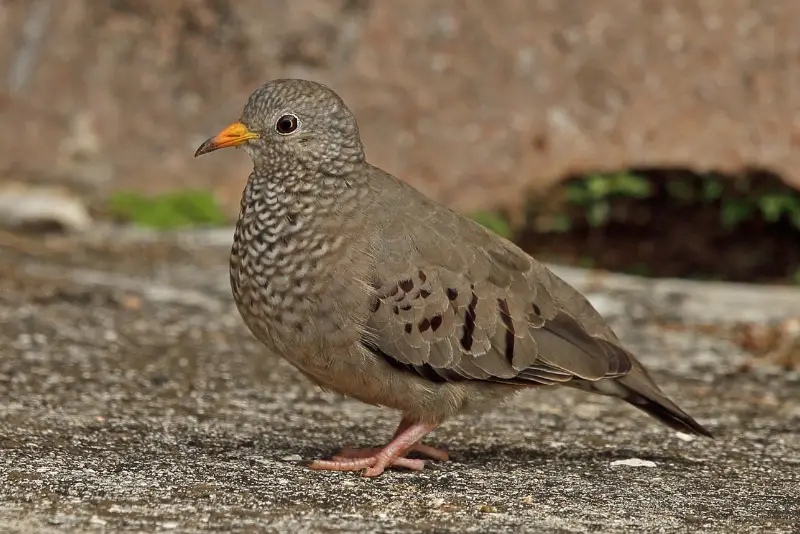
The Common Ground Dove is a small California dove that’s about the size of a sparrow. It is a species of southern US states, and can be found breeding in southern California.
The overall coloration of these birds is brownish gray, with chestnut tones on the wings. In combination with their small size, the subdued dusty color makes these birds hard to spot on the ground.
Often you won’t notice these birds until you flush them from the ground, and see them flying away.
Another great way to identify them is by their repetitive coo-ing call, which is audible even if you can’t catch a glimpse of the bird since it’s hidden in thick scrub.
Common Ground Doves are year-round residents in the southern parts of the state. They readily visit ground bird feeders that offer shelled sunflower seeds and other seeds.
In their original desert habitat, these birds are opportunistic breeders that raise their young after plentiful rainfall leads to an abundance of seeds.
They nest on the ground, which makes them vulnerable to predators. This explains why these birds are so well camouflaged, which allows them to blend in with their surroundings.
Blue Grosbeak
Scientific name: Passerina caerulea

The Blue Grosbeak is a beautiful songbird that has a large beak that is shaped like a cone.
The adult males are almost entirely dark blue in color, except for two chestnut-brown wingbars and black feathers on their face.
Females, on the other hand, are brownish gray with pale underparts. This grosbeak is a breeding visitor throughout California, but migrates to Central America to spend the winter.
The preferred habitat of this bird is shrubland and grassland interspersed with dense bushes.
American Goldfinch
Scientific name: Spinus tristis
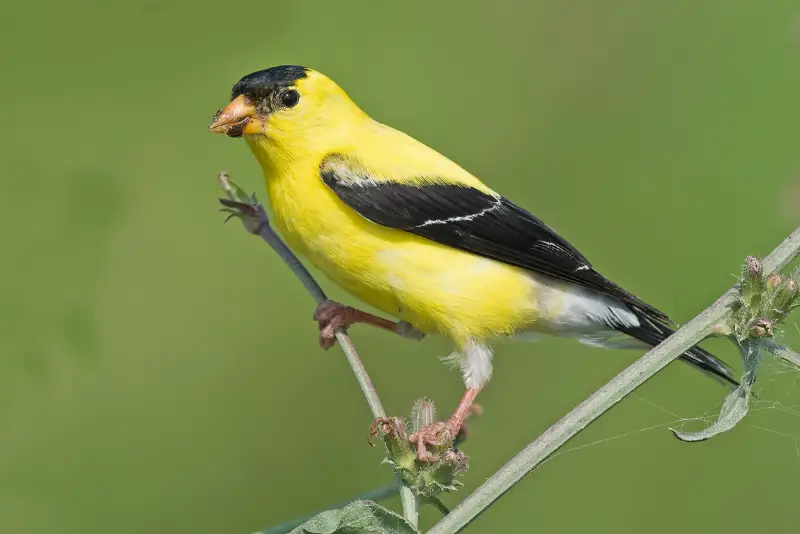
The American Goldfinch is a winter visitor in California, and can be seen between October and April in many parts of the state.
It has a dazzling, bright yellow color with a black forehead.
Their wings are black and decorated with white markings. The females are a bit quite different though, having a primary olive color and dull yellow underparts that are a lot paler than the male’s.
The American Goldfinch is usually found in weedy fields and floodplains, but can also be found in orchards, roadsides, and as backyard birds.
It generally likes to eat seeds and grains, and is readily attracted to bird feeders that offer black oil sunflower seeds.
Chipping Sparrow
Scientific name: Spizella passerina
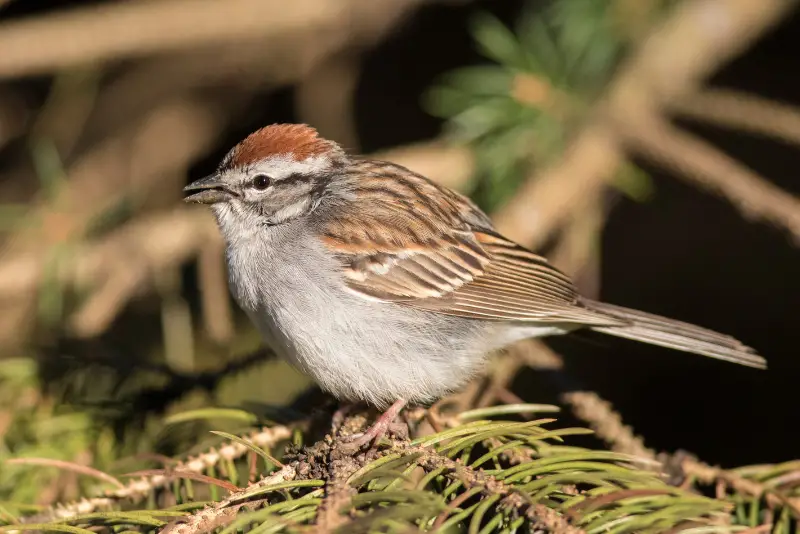
The Chipping Sparrow is a common bird in many man made habitats, including backyards, gardens, and parks.
Adult birds can be recognized by their chestnut crown, which contrasts with a white supercilium (or eyebrow stripe) and black eye stripe.
The Chipping Sparrow is a widespread breeding bird in California, where it can be seen as a summer visitor from May through October.
These birds migrate south and spend the winter in the southern USA, as well as Mexico and Central America.
Song Sparrow
Scientific name: Melospiza melodia
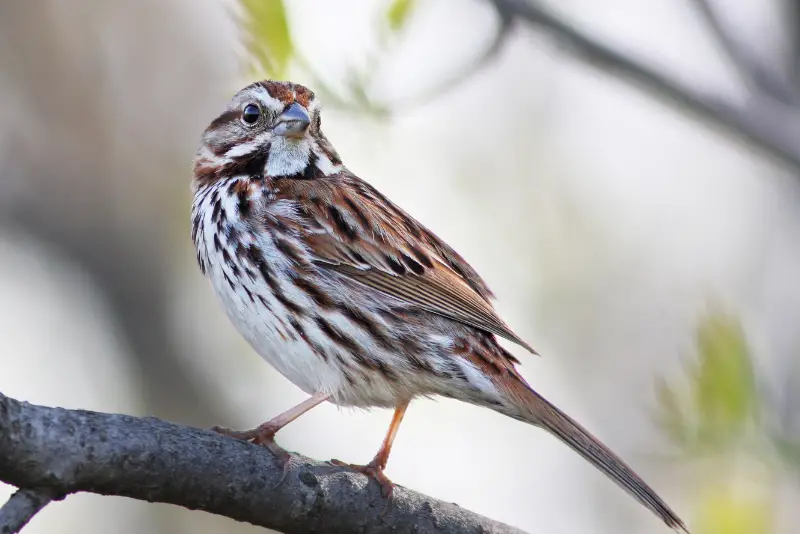
The Song Sparrow is an inconspicuous little brown bird, but can be recognized by its dark breast markings that merge into a central black spot.
The back is reddish brown with dark brown streaks, and the reddish wings have two white wingbars.
The Song Sparrow is a common summer visitor in California, where it can be seen from April to October.
It spends the winter in more southern states, and also in Mexico. Song Sparrows prefer fields and meadows with scrubs and dense bushes.
What are the small brown birds found in California?
The small brown birds that can be regularly seen in California backyards are wrens, which are tiny birds with a loud voice.
The most common wren species in California is the House Wren, which is found throughout the state in summer, while the Rock Wren replaces it in more remote mountainous areas.
In addition to wrens, female House Finches are also small birds that are brownish gray, and are commonly found in backyard gardens all over California.
How can you attract California birds to your backyard?
The top 5 things you can do to get these birds to visit your backyard are as follows:
- Set up a feeder with sunflower seeds, or a bird seed mix
- Set up a bird bath
- Plant shrubs to provide nesting opportunities
- Plant native fruiting plants to provide foraging opportunities
Tip: If you want to attract Western Bluebirds to your backyard feeder, it’s best to offer berries or mealworms, since they’re not interested in seeds.
If you enjoyed this article, check out our guide to the large birds of California.
